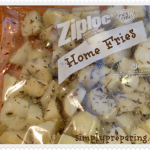Find a great sale on frozen vegetables, but there's no room in the freezer? No worries! Dehydrating frozen vegetables is a simple prep skill to master. Why You Should Dehydrate Frozen Vegetables Unless you have a really big garden, dehydrating frozen vegetables is much cheaper than buying fresh, and you can dehydrate frozen vegetables year round. Dehydrating … [Read more...] about Dehydrating Frozen Vegetables
Dehydrated Food
Preserve blackberries for long term storage
I love to preserve blackberries. It's so easy to insure the great taste of summer in your food preps with just a small amount of work. Rich in bioflavonoids, vitamin C and antioxidants, blackberries are nutritional power houses perfect for long term food storage pantries. Here are my favorite ways to preserve blackberries. How To Freeze Blackberries One way to … [Read more...] about Preserve blackberries for long term storage
Suburban Homesteading
While talking with a group of friends, each of whom expressing a wish to buy land to homestead on. I couldn't figure out why my friends felt the need to wait until they had a bigger plot of land to begin their journey to self sufficiency. Why not start homesteading in your own backyard? Right now! Suburban Homesteading. It really is a 'thing'! Let's face it. Not … [Read more...] about Suburban Homesteading
Egg Prices are Going Up. Way Up.
Egg prices are going up. An announcement was made at the beginning of January alerting consumers to a price hike in eggs as California starts requiring hens be raised in spaces big enough to move around in. States selling eggs to California must also meet these standards in order to continue doing business in the Golden State. *this post contains affiliate links Less … [Read more...] about Egg Prices are Going Up. Way Up.
Prepping With Potatoes
Potatoes are cheap, store well, and are easy to find thus making them a great friend of preppers. Recently 10# bags of potatoes have been on sale for $1.99 in my area leading me to search for many ways that prepping with potatoes can be done. Here is how I have been using these sales to further increase my food stores. Prepping With Potatoes - Dehydrating and Freezing For … [Read more...] about Prepping With Potatoes





